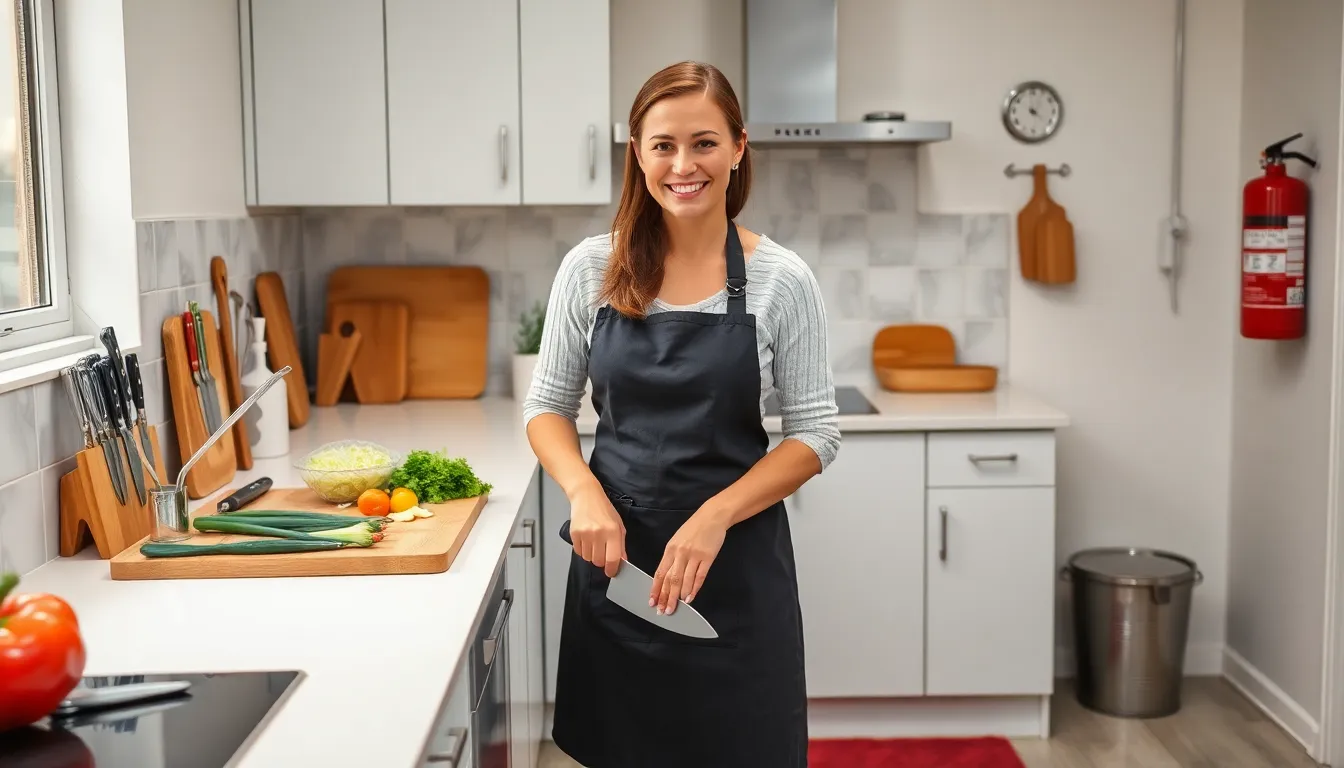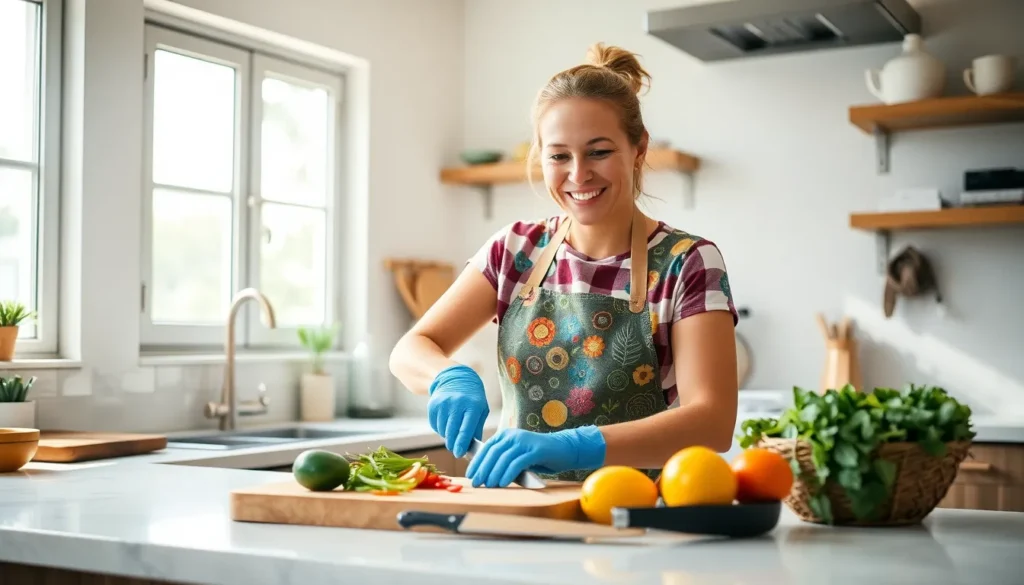Table of Contents
ToggleThe kitchen is often the heart of the home, bustling with activity and delicious aromas. However, it can also be a dangerous place if safety isn’t prioritized. From sharp knives to hot surfaces, potential hazards lurk around every corner, making it essential to be aware of best practices for a safe cooking environment.
Implementing kitchen safety tips not only protects individuals but also enhances the overall cooking experience. By adopting simple yet effective measures, anyone can reduce the risk of accidents and injuries. Whether it’s learning how to properly handle kitchen tools or understanding safe food storage, these tips are crucial for creating a secure space where creativity can flourish.
Importance Of Kitchen Safety
Kitchen safety is crucial for preventing accidents and injuries while cooking. The kitchen, often a hub of activity, can expose individuals to various dangers, including cuts, burns, and slips. Understanding these risks fosters a safer environment for everyone.
Implementing safety measures enhances the cooking experience. Proper tool handling, such as using knives with caution and storing utensils correctly, minimizes injury chances. Keeping floors clean and dry reduces slip hazards, contributing to a safer workspace.
Awareness of food safety is essential. Following guidelines for food storage prevents contamination and foodborne illnesses. By maintaining a clean kitchen, individuals can create an inviting atmosphere that encourages culinary creativity without compromising safety.
Investing in kitchen safety isn’t merely about avoiding accidents; it promotes confidence in cooking. A secure kitchen environment inspires individuals to experiment with new recipes and techniques, ultimately leading to healthier meals and more enjoyable cooking experiences.
Common Kitchen Hazards

Recognizing common kitchen hazards is essential for maintaining a safe cooking environment. Awareness of specific dangers helps prevent accidents and injuries in the kitchen.
Sharp Objects
Sharp knives, graters, and other cutting tools pose significant risks. Using dull knives can lead to accidental slips while cutting. Always cut away from the body and utilize cutting boards for stability. Store knives in designated blocks or sheaths to prevent accidental cuts. Additionally, when handling glass or ceramic items, avoid direct contact with sharp edges to minimize lacerations.
Slips And Falls
Wet floors and cluttered surfaces frequently contribute to slips and falls. Immediately wipe up spills and maintain a clean workspace to reduce risks. Use non-slip mats in areas prone to moisture, like near the sink. Ensure that walkways remain free of obstacles, such as electrical cords and trash, to create a safer kitchen environment.
Fires And Burns
Fires and burns represent severe hazards in the kitchen. Keeping flammable materials away from stovetops and ovens minimizes fire risks. Always monitor cooking food to prevent overheating and potential flare-ups. Use oven mitts for handling hot pots and pans, and ensure proper storage of cooking oils to avoid spills that could ignite. Having a fire extinguisher within reach is crucial for immediate response in case of emergencies.
Essential Kitchen Safety Tips
Ensuring safety in the kitchen is critical for preventing accidents and fostering a secure cooking environment. The following guidelines offer vital practices for maintaining safety in the kitchen.
Proper Knife Handling
- Always use a cutting board to stabilize items during cutting.
- Always cut away from the body to avoid accidental injuries.
- Always store knives in a dedicated knife block or magnetic strip to keep them out of reach.
- Always keep knives sharp; dull knives can slip and cause injuries.
- Always clean knives immediately after use and avoid placing them in sinks where they aren’t visible.
Safe Cooking Practices
- Always supervise cooking, especially when using high heat or boiling liquids.
- Always use oven mitts or pot holders when handling hot cookware to prevent burns.
- Always follow recipe instructions to avoid food mishaps, such as overcooking.
- Always maintain a clutter-free cooking area to reduce the risk of slips.
- Always keep cooking surfaces clean and dry to prevent food contamination.
Fire Safety Measures
- Always keep flammable materials, such as towels and paper, away from heat sources.
- Always monitor stovetops while cooking to prevent overheating and ignitions.
- Always install smoke detectors in or near the kitchen and test them regularly.
- Always have a fire extinguisher within reach and ensure it’s suitable for kitchen fires (Class K).
- Always be aware of the correct method to extinguish a grease fire, using a lid or baking soda, rather than water.
Chemical Safety
- Always store cleaning supplies in a designated area, away from food items.
- Always read labels for proper usage instructions and warning symbols before using chemicals.
- Always wear gloves and ensure adequate ventilation when handling strong cleaning agents.
- Always dispose of expired or unused chemicals according to local regulations to avoid hazardous situations.
- Always keep emergency contact information readily available, including poison control.
Maintaining A Safe Kitchen Environment
Creating a safe kitchen environment hinges on organization and cleanliness. Implementing specific practices ensures safety and enhances the cooking experience.
Organization And Cleanliness
Maintaining organization and cleanliness in the kitchen prevents accidents and improves efficiency. Clear countertops allow for focused work, while properly organized drawers and cabinets make tools accessible.
- Store items properly: Place sharp tools in designated areas, use drawer dividers, and label containers for easy identification.
- Keep floors tidy: Sweep and mop regularly to remove food debris and prevent slips.
- Clean as you go: Wipe surfaces after spills and avoid clutter by putting items away promptly.
- Use proper storage: Store food in sealed containers to avoid contamination and label all items for easy retrieval.
Child Safety Measures
Implementing child safety measures creates a secure kitchen environment for families. Awareness of potential hazards protects children from common kitchen accidents.
- Store hazardous items out of reach: Place knives, scissors, and cleaning supplies in high cabinets or locked drawers.
- Use corner guards: Install corner guards on sharp edges of countertops to minimize injury risks.
- Supervise children: Always keep a watchful eye on children while in the kitchen, particularly when cooking is in progress.
- Teach safe kitchen practices: Educate children about hot surfaces, sharp tools, and the importance of asking for help when needed.
Prioritizing kitchen safety is essential for creating a secure cooking environment. By following the recommended safety tips individuals can significantly reduce the risk of accidents and injuries. Simple practices like proper knife handling and maintaining a clean workspace can make a world of difference.
Moreover staying organized and aware of potential hazards fosters a more enjoyable cooking experience. With the right precautions in place individuals can focus on their culinary creativity without the worry of mishaps. Embracing these safety measures not only protects everyone in the kitchen but also enhances the overall joy of cooking.







